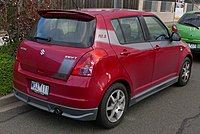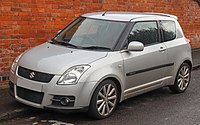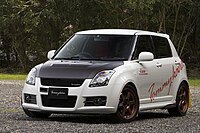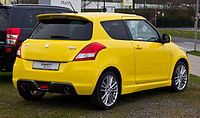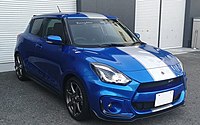
A | B | C | D | E | F | G | H | CH | I | J | K | L | M | N | O | P | Q | R | S | T | U | V | W | X | Y | Z | 0 | 1 | 2 | 3 | 4 | 5 | 6 | 7 | 8 | 9
| Suzuki Swift | |
|---|---|
 Third generation Suzuki Swift | |
| Overview | |
| Manufacturer | Suzuki |
| Production | September 2004[1] – present Nameplate first used in 1984[2] |
| Body and chassis | |
| Class |
|
| Body style |
|
| Layout | |
| Chronology | |
| Predecessor |
|
The Suzuki Swift (Japanese: スズキ・スイフト, Suzuki Suifuto) is a supermini car (B-segment) produced by Suzuki. The vehicle is classified as a B-segment marque in the European single market, a segment referred to as a supermini in the British Isles. Prior to this, the "Swift" nameplate had been applied to the rebadged Suzuki Cultus in numerous export markets since 1984[2] and for the Japanese-market Suzuki Ignis since 2000. The Swift became its own model in 2004.[3][4] Currently, the Swift is positioned between Ignis and Baleno in Suzuki's global hatchback lineup.
Predecessors
International (1984–2003)
The Suzuki Swift nameplate began in 1984 as an export name for the Suzuki Cultus, a supermini (or subcompact) manufactured and marketed worldwide since 1983 across three generations and four body configurations—three-door hatchback, four-door sedan, five-door hatchback and two-door convertible—and using the Suzuki G engine family. The third generation was only sold in North America; the second generation remained in production for other markets across the world.
The Swift was marketed in the Japanese domestic market (JDM) as the Cultus and elsewhere as the Suzuki SA310, Suzuki Swift, Suzuki Forsa, Chevrolet Swift, Chevrolet Sprint and Sprint Metro, Geo and Chevrolet Metro, Pontiac Firefly, Maruti 1000, Holden Barina and Subaru Justy. Versions of the second generation Cultus were also produced until 2007 in India and the car remained in production until 2016 in Pakistan and China.
-
First generation (1985–1988)
-
Second generation (1988–2003)
-
Third generation (1995–2001, North America only)
Japan (2000–2006)
In Japan, the Swift nameplate was introduced in 2000 as a replacement for the Suzuki Cultus. Outside Japan, the "Suzuki Ignis" name was used. Both three- and five-door hatchback body styles were offered, although the three-door was not offered as part of the regular lineup in Japan.
The Swift was powered by a new generation of Suzuki inline-four gasoline engines, the M family. Engine displacements of 1.3- and 1.5-litres were offered, both with a five-speed manual transmission or optional four-speed automatic. The vehicle was available with either front- or four-wheel drive. Vehicles fitted with the 1.3-litre engine were designated HT51S, with the 1.5-litre version assigned HT81S.[5]
The three-door body variant formed the basis of the Swift Sport in Japan, or Ignis Sport in export markets. Introduced in 2003, it featured redesigned bumpers and was fitted with a higher-output version of the 1.5-litre engine, producing 115 PS (85 kW; 113 hp). The Sport ceased production in 2005, with the regular Swift (1.3-liter SE-Z trim) remaining until 2006 and sold side by side with the first generation global version Swift since November 2004.[3]
-
2000–2003 Suzuki Swift
-
2003–2006 Suzuki Swift
-
Suzuki Swift Sport
-
Suzuki Swift Sport (rear)
First generation (RS; 2004)
| First generation | |
|---|---|
 3-door hatchback 1.5 XS (pre-facelift) | |
| Overview | |
| Model code | RS |
| Production | |
| Assembly |
|
| Designer | Yasukazu Yuki and Hirohito Matsumoto[8][9] |
| Body and chassis | |
| Related | |
| Powertrain | |
| Engine | |
| Transmission | |
| Dimensions | |
| Wheelbase | 2,390 mm (94.1 in) |
| Length |
|
| Width | 1,690 mm (66.5 in) |
| Height |
|
| Curb weight | 1,000–1,100 kg (2,205–2,425 lb) |
RS413/413D/415
The global version of the first generation Swift was debuted at the Paris Motor Show in September 2004.[10][3] The design of the Swift was previewed on the Concept S and Concept S2 concept cars at auto shows, in the years leading up to its launch.[4] This generation of the Swift marked a significant departure with the previous Cultus-based models, with Suzuki redesigning the vehicle as less of a "low price alternative" subcompact and more of a "sporty" subcompact.[11] The Swift's design and driving characteristics focused on the European market with its chassis refined through a road-testing program across Europe.[12]
The first generation Swift has received four stars out of five ratings in the Euro NCAP crash tests.[13] It also was awarded 2006 Semperit Irish Car of the Year in Ireland.[14]
Since its global launch in 2005, which was kicked off with a marketing campaign fronted by the footballer Cristiano Ronaldo in many European countries, the Swift has recorded above forecast sales in most markets. In Japan, sales figures reached twice the numbers forecast.
The Swift was available with 1.3- and 1.5-litre petrol engines, rated at 91 PS (67 kW; 90 bhp) and 102–110 PS (75–81 kW; 101–108 hp), respectively. It was produced in Hungary, India, Indonesia, Japan, Pakistan and by Chang'an Motors in China. In most markets, only the five-door body is available, and a four-wheel drive is an option for the 1.3- and 1.5-litre petrol engines. A 92 PS (68 kW; 91 bhp) 1.2-litre engine fitted with an automatic continuously variable transmission (CVT) was offered in front-wheel drive only. In Europe, the Swift was launched in three- and five-door hatchback forms, with 1.3- and 1.5-litre petrol engines, and a 1.3-litre DDiS turbo-diesel engine supplied by Fiat. Both the 1.3-litre and 1.5-litre petrol models are available with four-wheel drive; these models receive the ZD11S and ZD21S chassis numbers.[15]
Pak Suzuki Motor Company Limited started producing the first generation Swift in November 2009 and only available with 1.3-litre M13A petrol engine and paired with either 5-speed manual or 4-speed automatic transmissions. The first generation Swift was discontinued in Pakistan in August 2021.[6]
In Indonesia, the earlier Swift was imported from Japan and from 2007 to 2011, it was assembled locally at Suzuki Indomobil Motor's production plant in Bekasi, West Java. It was only offered with a 1.5-litre M15A petrol engine, mates with either 5-speed manual or 4-speed automatic transmissions. There were several special editions with Swift Sport bumpers, sold as GT (2007), GT2 (2009) and GT3 (2010), respectively.[16] There was also a special edition called GTS with body kits launched in July 2009.[17]
The Maruti Suzuki Swift was launched in India on 25 May 2005 with the familiar 1.3-litre SOHC 16-valve G13BB petrol engine seen in Maruti Esteem. Later, in early 2007, Maruti introduced the Swift with a Fiat-sourced 1.3-litre Fiat's DDiS turbo-diesel engine. In 2010, due to the new BS-IV emission norms, Maruti replaced the 1.3-litre petrol engine with the more modern 1.2-litre DOHC (later model has VVT) K12M engine.[18]
-
Suzuki Concept S (2002)
-
Suzuki Concept S2 (2003)
-
Suzuki Swift RE.3 Edition (Australia)
-
Suzuki Swift RE.3 Edition (Australia)
-
Suzuki Swift GT3 Edition (Indonesia)
Changan Suzuki Swift
Suzuki's joint venture in China, Changan Suzuki, started producing Swift for the Chinese domestic market in Chongqing from July 2005.[3] Two petrol engines were available; 1.3-litre SOHC G13BB engine producing 85 PS (63 kW; 84 hp)[19] and 1.5-litre DOHC VVT M15A engine producing 100 PS (74 kW; 99 hp).[20] Both engines are mated with a 5-speed manual transmission, while the later was available with a 4-speed automatic transmission option. A limited edition Swift with new sporty bumpers called Champion Edition was introduced in June 2010.[21][22]
While the new generation Swift was prepared for the global market, Changan Suzuki continued producing this generation by giving its first facelift by using Swift Sport bumpers and rear lights in October 2010, skipped the 2007 facelift for the global market model. Suzuki did testing the new generation Swift in China but decided only offered the Japanese imported high performance Swift Sport instead.[23][24]
The second facelift occurred in 2013 and it has similar front bumper styling as the refreshed second generation Swift.[25]
Sales ended when Suzuki decided to withdraw from Chinese market to focus in India in September 2018.[26] Over 350,000 units Swift were sold in China from 2005 to 2019.[27]
-
Pre-facelift of 1.5 model with 2-bar grille
-
First facelift with Swift Sport bumpers
-
Second facelift with global's 2013 facelift styling
-
Rear view of second facelift
Swift Sport (RS416/ZC31S)
In September 2005, Suzuki launched the Sport version of the new Swift in Japan, and in September 2006 the model was introduced in most European markets. Named "Swift Sport", it is powered by an enhanced M16A unit, a high-revving 1.6-litre, naturally aspirated DOHC VVT four-cylinder engine with an 11.1:1 compression ratio, high lift cams, forged pistons, and strengthened valve springs. The 1.6-litre engine produces 125 PS (92 kW; 123 bhp) and 148 newton-metres (109 lb⋅ft) torque. At 3,765 mm (148.2 in), the car is 70 mm (2.8 in) longer than the standard Swift. The Swift Sport features sportier bumpers and spoilers, a stiffer suspension, twin exhaust pipes, red sport seats (with Recaro seats optional) and four-wheel disc brakes on 16-inch wheels. The European Swift Sport features five-speed manual transmission, the three-door body variant, 17-inch wheels (16-inch also available) and electronic stability control (ESC).
In July 2008, Suzuki Germany launched a limited edition of Swift Sport called N'Style Rally to pay tribute to the Suzuki's Group N Junior World Rally Championship car and only limited to 500 units. It was offered exclusively in black and is covered with Suzuki Motorsport’s logos and decals.[28]
In 2007, Suzuki Arena Kyoto Rakunan, a Suzuki's dealership located in Kyoto prefecture collaborated with Japanese car tunner Tommykaira to modify the Swift Sport and it was sold as Tommykaira S-Ss (Super Swift Sports).[29]
In 2008, the Swift Sport has undergone a minor restyling which mostly influenced the interior and gear ratios.
-
Suzuki Swift Sport 3-door
-
Suzuki Swift Sport 3-door
-
Suzuki Swift Sport 5-door
-
Suzuki Swift Sport N'Style Rally Edition
-
Tommykaira S-Ss
-
Interior
Engines
| 1.3 | 1.5 | 1.6 | 1.3 DDiS | |
|---|---|---|---|---|
| Engine: | inline-4 Petrol | inline-4 Diesel | ||
| Displacement: | 1328 cc | 1490 cc | 1586 cc | 1248 cc |
| Power: | 68 kW (92 hp)/5800 | 75 kW (102 hp)/5900 | 92 kW (125 hp)/6800 | 55 kW (75 hp)/4000 |
| Torque: | 116 Nm/4200 | 133 Nm/4100 | 148 Nm/4800 | 190 Nm/1750–2250 |
| Gearbox, standard: | 5-Speed manual | |||
| Gearbox, optional: | 5-Speed-Automatic | 4-Speed Automatic | — | |
| Weight: | 1045–1135 kg | 1095 kg | 1105 kg | 1140 kg |
| Top speed: | 167–175 km/h | 180–185 km/h | 200 km/h | 165 km/h |
| Acceleration, 0–100 km/h: | 11.0–12.5 s | 10.0–11.7 s | 8.9 s | 13.7 s |
| Fuel consumption on 100 km (combined): |
5.8–6.2 L Super | 6.5 L Super | 7.0 L Super | 4.5 L Diesel |
Safety
Second generation (AZG; 2010)
| Second generation | |
|---|---|
 3-door hatchback (pre-facelift; UK) | |
| Overview | |
| Model code | AZG |
| Production | June 2010 – 2017 |
| Assembly |
|
| Designer | Hisanori Matsushima, Hirohito Matsumoto, Tetsuya Ozasa, Akihito Igarashi, Takashi Maeda and Hiroyuki Tokuda[32][33][34] |
| Body and chassis | |
| Related | |
| Powertrain | |
| Engine | |
| Transmission | |
| Dimensions | |
| Wheelbase | 2,430 mm (95.7 in) |
| Length |
|
| Width | 1,695 mm (66.7 in) |
| Height |
|
| Curb weight | 960–1,090 kg (2,120–2,400 lb) |
| Chronology | |
| Successor | Suzuki Baleno (Indonesia) |
AZG412/413D/414
The second generation Swift was unveiled on 26 August 2010. It went on sale in Japan on 18 September 2010. The second generation Swift production at Suzuki's plant in Hungary started on 11 June 2010[31] to be supplied across Europe. The new car has its wheelbase extended by 50 millimeters over the previous generation and has many visual updates. While the new car looks different from the old one, its design is an evolution of the radical first generation styling with a longer and more rounded appearance. During September 2010, Suzuki in the United Kingdom released the second generation Swift onto British roads.
The new generation is expected to feature a 1.2-litre VVT petrol engine (K12B) developing 92 PS (68 kW; 91 bhp). In some countries, the second generation of Suzuki Swift uses a 1.4-litre VVT petrol engine (K14B) which produces 95 PS (70 kW; 94 bhp).
In Thailand, the Swift was built locally since March 2012[3] and is part of the Thai government's eco-car program. The car was sold there with a CVT automatic transmission on GA, GL and GLX variants; GA and GL variants are also offered with a five-speed manual transmission, without anti-lock brakes.[35] Another variant with the Japanese market RS body kit was later added, as the RX trim.
For the Indonesian market, the Swift was launched on 20 September 2012 at the 20th Indonesia International Motor Show and sold in two trim levels: GL and GX, both available with manual or automatic transmission. The GS trim level was added on 6 June 2015, which was launched at the 2015 Jakarta Fair. The GS trim added HID projector headlights equipped with auto-levelling. Sales of the Swift in that market ended in April 2017. It was replaced by the Baleno hatchback in August 2017, which is slightly bigger and positioned in the same class as the second generation Swift, as the third generation Swift was not released in that market.
For the Malaysian market, the Swift was released in January 2013, imported from Thailand. It is available with three trim levels; GL, GLX and GLX-S.[36] The CKD version was later launched in May 2013.[37] A limited edition called RS based on GLX trim with GLX-S' body kit, decals and red accents interior was launched later in June 2014.[38] The facelifted model launched in July 2015 and followed by RR2 special edition based on GL trim in September.[39][40]
2013 update
For 2013, Suzuki updated the Swift with some minor cosmetic changes such as a revised front bumper, L-shaped LED daytime running lights on the foglamp housings, fresh 16-inch wheels, LED-type high-level brake lamp and new seat fabric design.[41]
For the Japanese market, it features Suzuki's newly developed Dualjet engine as well as Suzuki's ENE-CHARGE system and ECO-COOL, implemented from the Suzuki Wagon R. The new Dualjet engine uses the dual-injection system on its 1.2-litre petrol engine and it works by increasing vaporisation, making combustion more efficient. It channels fuel to two intake ports instead of only one per cylinder. With the Dualjet technology and the ENE-CHARGE, fuel economy is now up to 26.4 km/L, calculated based on JC08 mode.[42][43]
-
2013 facelift model
Swift Sport (AZG416/ZC32S)
The Swift Sport was previewed by the Swift S-Concept which was showcased first at the 2011 Australian International Motor Show.[44] The production model of Swift Sport is powered by a revised 1.6-litre four-cylinder (M16A) from previous generation Swift Sport's engine and producing 136 PS (100 kW; 134 bhp) and 160 N⋅m (118 lb⋅ft). The 2012 model comes with the option of a six-speed manual transmission or a high performance CVT transmission with seven-speed manual mode and paddle shifters.[45]
Riding on lightweight 17-inch alloys, the car now features a rear spoiler, a large front grille, body kit, new HID headlights and rear lighting clusters. The ground clearance is also lower than the normal version. Inside, designers included leather bucket seats with sporty red stitching and a "Sport" mark, a new steering wheel, and different instrumentation.
In January 2014, The Swift Sport was updated to include a 6.1 inch combined satnav/dab radio infotainment touchscreen as standard.
In the United Kingdom, Suzuki has released another special edition of the Swift, the SZ-R, with a list price of £14,249 and limited to just 100 units.[46][47] In August 2014, Suzuki launched this vehicle for Brazilian market simply as Swift Sport R. It has higher engine output, producing a claimed 142 PS (104 kW; 140 bhp).[48]
-
Suzuki Swift Sport 3-door
-
Suzuki Swift Sport 3-door (rear)
-
Suzuki Swift Sport 5-door
Safety
- ANCAP (2011) -




 [49]
[49] - ASEAN NCAP (2013) -




 [50]
[50] - Euro NCAP (2010) -




 [51]
[51] - Global NCAP (2014, similar to Latin NCAP 2013, no airbags - Indian market) -




 [52]
[52] - Latin NCAP (2014, Indian-made most basic Latin American version)-




 [53][54]
[53][54]
Third generation (A2L; 2016)
| Third generation | |
|---|---|
 Pre-facelift Suzuki Swift with slant grille (UK) | |
| Overview | |
| Model code | A2L |
| Production |
|
| Model years | 2017–present |
| Assembly |
|
| Designer | Kimitoshi Sato and Toshiyuki Koike[57] |
| Body and chassis | |
| Platform | HEARTECT B platform[58] |
| Related | |
| Powertrain | |
| Engine |
|
| Electric motor |
|
| Transmission | |
| Hybrid drivetrain |
|
| Battery |
|
| Dimensions | |
| Wheelbase | 2,450 mm (96 in) |
| Length |
|
| Width |
|
| Height |
|
| Curb weight |
|
The third generation Swift debuted in Japan on 27 December 2016.[59] The hatchback is built on the HEARTECT platform which made its debut in 2015 and is the same lightweight platform used for the production of the hatchbacks Baleno and Ignis. This new lightweight platform made the third generation Swift roughly 10% lighter than the previous generation.[60] Only 5-door body style is available, even though the car looks like a 3-door because the rear door handles are moved to the C-pillar. Despite having similar size as the previous generation (10 mm shorter, 10 mm lower, 40 mm wider and 20 mm longer wheelbase), the boot space is also roughly 20% more spacious (now 246 litres, up to 579 liters when the rear seats are folded), but still smaller than its competitors.[60]
This generation is also the first that uses the newly developed Boosterjet direct injection turbocharged petrol engines and Smart Hybrid Vehicle by Suzuki (SHVS) mild hybrid technologies. The compact and lightweight 12 or 48-volt mild hybrid system features a belt-driven Integrated Starter Generator (ISG), which assists the engine during acceleration and helps recoup energy via regenerative braking. In Japan, a 48-volt full hybrid model is available for the 1.25-litre four-cylinder petrol engine, it is connected to a Motor Generator Unit (MGU) and 5-speed clutchless automated manual transmission (AGS).[61]
Additional safety kits are also updated, such as; a forward-facing camera and laser sensors that deliver lane departure warning and high-beam assist, along with autonomous emergency braking.[60]
The European market Swift is no longer built by Magyar Suzuki in Hungary, it is now supplied from Japan and also exported to areas including Asia, Oceania and Latin America.[62] It is also manufactured in India, Thailand and Myanmar.[62][63] The Indian-built Swift is exported to Africa, parts of Asia, and some Latin American and Middle Eastern markets. The third generation Swift is also manufactured in Pakistan and Ghana since 2022 and 2023, respectively.[55][56]
-
Pre-facelift Suzuki Swift with mesh grille (Japan)
-
Pre-facelift Suzuki Swift RS (Japan)
-
Rear view of Suzuki Swift (UK)
-
Rear view of Suzuki Swift RS (Japan)
-
Interior
Facelift
The Suzuki Swift received a minor facelift in May 2020 for the Japanese market.[64] European market received the facelifted model in September 2020.[65] It was also released in November 2020 for the Mexican market,[66] in February 2021 for the Thai and Indian market,[67][68] and in the Philippine market in March 2022.[69]
The hatchback received new radiator grille, alloy wheels and dual tone colour option. Some features from the higher trim now become available for lower trims,[70][71] some markets also received new features from other markets which was standard in the pre-facelift model.[72] The engine is also revised for markets with stricter emission standards (see below). The 12-volt mild hybrid system has also been upgraded with a bigger 10Ah battery, replacing the old 3Ah unit to boost energy recovery.[70]
-
Facelifted regular Suzuki Swift (Germany)
-
Facelifted Suzuki Swift RS (Japan)
-
Facelifted Suzuki Swift Hybrid received RS bumpers (Japan)
Swift Sport (A2L414/ZC33S)
Suzuki officially unveiled the Swift Sport at the 2017 Frankfurt Motor Show. The car comes with a 1.4-litre turbocharged K14C Boosterjet engine shared with the Vitara S. The engine makes 140 PS (103 kW; 138 bhp) DIN at 5,500 rpm and 230 N⋅m (170 lbf⋅ft) of torque at 2,500–3,000 rpm. It comes equipped with either a 6-speed manual or a 6-speed automatic transmission. Aesthetically, the Swift Sport has a completely new front and rear bumpers, a rear spoiler, 16 or 17-inch alloy wheels, dual exhaust, wider tyres, a front chin spoiler and red accents interior.
In June 2020, Suzuki launched Swift Sport with Suzuki's SHVS 48-volt mild hybrid technology for European market to meet Euro 6d emission standard. Still with the 1.4-litre turbocharged engine (now called K14D Boosterjet), revised with dual VVT and smaller turbocharger. It is now makes 129 PS (95 kW; 127 bhp) at 5,500 rpm and 235 N⋅m (173 lbf⋅ft) of torque at 2,000–3,000 rpm and also 55 kg heavier than the old 6-speed manual non-hybrid model.[73] This version is also available in Singapore, Taiwan, Hong Kong, Macau and Malaysia. The Sport version did not receive any facelift like the regular Swift, except the additional dual tone colour option.
-
Suzuki Swift Sport (UK)
-
Rear view Suzuki Swift Sport (Japan)
-
Interior
Limited editions
For Italian market, a limited edition Swift Sport BeeRacing was launched in March 2018.[74] In June of the same year, 100 units limited edition Swift Sport, called the Red Devil was announced for the Australian market.[75]
In May 2019, a limited edition Swift Sport Katana was launched for Dutch market only. The limited edition hot hatch pays tribute to the new Suzuki Katana 1000 bike. Built in a limited run of only 30 units, it comes in two colours, 15 units Premium Silver Metallic and 15 units Super Black Pearl paints.[76][77]
Another limited edition for Italian market was launched in February 2021 to celebrate Suzuki MotoGP's 7th world championship title after Joan Mir won the 2020 MotoGP season. Dubbed as the World Champion Edition and only 7 unit were available for sale.[78]
Malaysian market received a limited edition called Silver Edition in October 2023. Compared to regular Swift Sport, the hatchback received additional styling upgrades such as exclusive metallic silver body color, red accents, carbon fiber finish and bigger 10-inch LCD display.[79]
Tommykaira m14
In 2019, Japanese car tunner Tommykaira launched a tuned car based on the ZC33S Swift Sport called the Tommykaira m14, 12 years after the ZC31S Swift Sport-based S-Ss was introduced in 2007.[29] It is available in three packages; Stage I, Stage II and Stage III.[80]
-
Suzuki Swift Sport-based Tommykaira m14 (Japan)
Special and limited editions
Similar special or limited editions of Swift with Japanese market honeycomb grille, front and rear spoiler, sidekirts, decals (depending on the markets) and additional accessories were launched in India, Philippines, South Africa, Australia, United Kingdom and several other markets.[81][82][83][84][85]
A special edition based on XG trim called XR Limited was launched for Japanese market in October 2018. The car received sporty exterior package from RS trim, additional "Suzuki Safety Support" safety kits and several comfort features from higher trim.[86] Another limited edition based on the updated XG trim was launched in November 2019, called the Hybrid MG Limited. Basically the car has similar package as the previous limited edition but without sporty RS trim bumpers and additional mild hybrid system as standard.[87]
In Thailand, a special edition called Swift GL Max Edition was launched in November 2020. Equipped with black coloured body kit, crossover-like flare fenders, shark fin antenna and decorated quad exhaust pipes.[88] Another special edition with different body kit called GL Plus was launched in August 2021[89] and limited edition with upgraded body kit called GL Plus Limitless Edition was launched in June 2022.[90]
In New Zealand, limited editions called SR, SR2 and SR3 with similar concept as the previous generations Swift were available from 2018 to 2021. The most notable changes were the wider 205/45 sport tires and 17-inch black alloy wheels.[91][92][93]
-
Suzuki Swift Attitude (UK)
-
Rear view of Suzuki Swift Attitude (UK)
-
Suzuki Swift GL Plus (Thailand)
-
Suzuki Swift GL Plus Limitless Edition (Thailand)
Powertrain

It is equipped with either a 1.25-litre 4-cylinder K12C Dualjet dual injectors petrol engine developing 90 PS (66 kW; 89 hp) and 120 N⋅m (89 lbf⋅ft) of torque or a 1.0-litre 3-cylinder K10C Boosterjet direct injection turbocharged petrol engine for the global market developing 111 PS (82 kW; 109 hp) and 160–170 N⋅m (118–125 lbf⋅ft) of torque, both engines are available for regular and mild hybrid forms depending on the market. As standard, all engines are mated with a 5-speed manual transmission (6-speed for Swift Sport), this transmission is also standard for mild hybrid (pre-facelift) and AWD (1.25-litre only) models in Europe. The 1.25-litre engine can be selected with CVT transmission option and the 6-speed automatic transmission option is available exclusively for the turbocharged engines.
For the Japanese market, the 1.25-litre K12C Dualjet engine is offered in three variants; regular petrol engine, mild hybrid and full hybrid, depending on the trim levels.[94] Unlike in Europe, the AWD model can be ordered with CVT transmission option and the full hybrid model is only available with a 5-speed clutchless automated manual transmission (AGS).[94] The 1.0-litre turbocharged engine was also offered in RSt trim until May 2020 and only available with automatic transmission. The engine is tuned to run with regular octane petrol (90–95 RON) which is only producing 102 PS (75 kW; 101 hp) and 150 N⋅m (111 lbf⋅ft) of torque.[95]
In India though, it is expected to come equipped the familiar 83 PS (61 kW; 82 hp) 1.2-litre 4-cylinder K12M petrol engine and a 75 PS (55 kW; 74 hp) 1.25-litre Fiat-sourced (D13A) turbo-diesel engine variant from the previous generations. The former is also available in Latin America, Caribbean, Africa, Middle East and several Asian countries; while the latter was only available for Indian market and discontinued in April 2020.[96]
The Thai-market third generation Swift received the reworked 1.2-litre K12M engine with Dualjet technology in February 2018.[97][98]
For the 2021 European model, due the implementation of Euro 6d emission standard, both 1.0-litre turbocharged and 1.25-litre engines were replaced by a brand new 1.2-litre K12D Dualjet dual VVT engine with 12-volt mild hybrid system and become standard engine in Europe.[70][71] This engine is also available for the facelifted Swift in New Zealand, Singapore, Taiwan, Hong Kong and Macau. In February 2021, the facelifted Indian market Swift received a brand new BS6 compliant 1.2-litre K12N Dualjet dual VVT engine.
Several countries in Latin America received K12C Dualjet mild hybrid engine option in November 2021, the engine is only available with a 5-speed manual transmission.
In August 2022, Maruti Suzuki launched CNG version of K12N Dualjet engine in India.[99]
| Petrol engines[100][101][102][103][104][105][106] | ||||||
|---|---|---|---|---|---|---|
| Engine/motor | Displacement | Power | Torque | Acceleration 0–100 km/h (0–62 mph) |
Top speed | Transmission |
| K10C Boosterjet I3-T |
996 cc (61 cu in) | 102 PS (75 kW; 101 hp) at 5,500 rpm (Japan) 111 PS (82 kW; 109 hp) at 5,500 rpm |
150 N⋅m (15 kg⋅m; 111 lb⋅ft) at 1,700–4,500 rpm (Japan; automatic) 160 N⋅m (16 kg⋅m; 118 lb⋅ft) at 2,000–3,500 rpm (automatic) 170 N⋅m (17 kg⋅m; 125 lb⋅ft) at 1,700–4,000 rpm (manual) |
10.6 s (manual) 10.0 s (automatic) |
190 km/h (118 mph) (automatic) 195 km/h (121 mph) (manual) |
5-speed manual 6-speed automatic |
| K10C Boosterjet SHVS I3-T + WA05A ISG | 111 PS (82 kW; 109 hp) at 5,500 rpm + 3.1 PS (2.3 kW; 3.1 hp) at 1,000 rpm |
170 N⋅m (17 kg⋅m; 125 lb⋅ft) at 1,700–4,000 rpm + 50 N⋅m (5 kg⋅m; 37 lb⋅ft) at 100 rpm |
5-speed manual | |||
| K12C Dualjet I4 |
1,242 cc (76 cu in) | 90–91 PS (66–67 kW; 89–90 hp) at 6,000 rpm | 120 N⋅m (89 lb⋅ft) at 4,400 rpm | Zdroj:https://en.wikipedia.org?pojem=Suzuki_Swift_S1600|||















